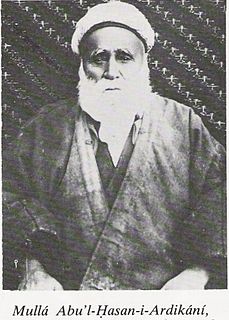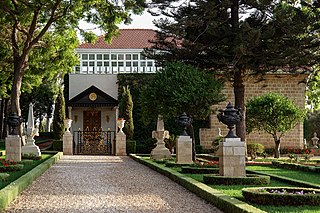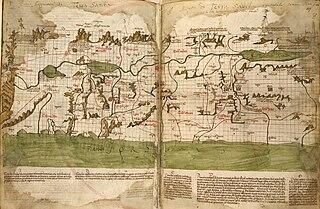Riḍván is a twelve-day festival in the Bahá'í Faith, commemorating Bahá'u'lláh's declaration that he was a Manifestation of God. In the Bahá'í Calendar, it begins at sunset on the 13th of Jalál, which translates to the 20th or 21st of April, depending on the date of the March equinox. On the first, ninth and twelfth days of Ridván, work and school should be suspended.
The following is a basic timeline of the Bábí and Bahá'í religions emphasizing dates that are relatively well known. For a more comprehensive chronology of the timeline, see the references at the bottom.

The Letters of the Living was a title provided by the Báb to the first eighteen disciples of the Bábí Religion. In some understandings the Báb places himself at the head of this list. In this article, the former notation will be used except when specifically said otherwise.
The Bahá'í/Bábí split occurred when most Bábís accepted Bahá'u'lláh as the messiah of the Báb's writings, leading them to become Bahá'ís, and leaving a remnant of Bábís who became known as Azalis. The split occurred after Bahá'í founder Bahá'u'lláh made his claims to be the messiah public in 1866, leading to expressions of support from the majority of the Bábí community, and opposition from Subh-i-Azal, who became the leader of the remaining group.

Mírzá Ḥusayn-i-Isfahání was a prominent Bahá'í and one of the nineteen Apostles of Bahá'u'lláh, as well as a famous calligrapher of 19th-century Persia. He is the author of a calligraphic rendering of the Greatest Name, used by Bahá'ís around the world.
Bahá'í history is often traced through a sequence of leaders, beginning with the Báb's declaration in Shiraz on the evening of May 22, 1844, and ultimately resting on an Administrative Order established by the central figures of the religion. The religion had its background in two earlier movements in the nineteenth century, Shaykhism and Bábism. Shaykhism centred on theosophical doctrines and many Shaykhis expected the return of the hidden Twelfth Imam. Many Shaykhis joined the messianic Bábí movement in the 1840s where the Báb proclaimed himself to be the return of the hidden Imam. As the Bábí movement spread in Iran, violence broke out between the ruling Shi'a Muslim government and the Bábís, and ebbed when government troops massacred them, and executed the Báb in 1850.
Mullá Muḥammad-i-Zarandí, more commonly known as Nabíl-i-A’ẓam or Nabíl-i-Zarandí, was an eminent Bahá'í historian during the time of Bahá'u'lláh, and one of the nineteen Apostles of Bahá'u'lláh. He is most famous for authoring The Dawn-Breakers, which stands out as one of the most important and extensive accounts of the ministry of the Báb.
The Apostles of Bahá'u'lláh were nineteen eminent early followers of Bahá'u'lláh, the founder of the Bahá'í Faith. The apostles were designated as such by Shoghi Effendi, head of the religion in the earlier half of the 20th century, and the list was included in The Bahá'í World, Vol. III (pp. 80–81).

Mullá Abu'l-Hasan-i-Ardikání, better known as Hájí Amín, was an eminent follower of Bahá'u'lláh, founder of the Bahá'í Faith. Amín served as the trustee of Huqúqu'lláh, was posthumously appointed a Hand of the Cause of God by Shoghi Effendi, and identified as one of the nineteen Apostles of Bahá'u'lláh.

Ḥají Mullá `Alí-Akbar Shahmírzádí, known as Ḥají Ákhúnd, was an eminent follower of Bahá'u'lláh, the founder of the Bahá'í Faith. He was appointed a Hand of the Cause, and identified as one of the nineteen Apostles of Bahá'u'lláh.

Mírzá Maḥmúd-i-Furúghí, also known as Fádil-i-Furúghí, was an eminent follower of Bahá'u'lláh, the founder of the Bahá'í Faith. He was the only Iranian Bahá'í teacher who was given the chance to meet face to face with a Qajar Shah. He was later identified as one of the nineteen Apostles of Bahá'u'lláh.

Mírzá `Alí-Muḥammad-i-Khurásání, known as Ibn-i-Aṣdaq, was an eminent follower of Bahá'u'lláh, the founder of the Bahá'í Faith. He was appointed a Hand of the Cause and identified as one of the nineteen Apostles of Bahá'u'lláh.

Hájí Mírzá Ḥasan-i-Adíbu'l-`Ulamá, known as Mírzá Ḥasan or Adíb, was an eminent follower of Bahá'u'lláh, the founder of the Bahá'í Faith He was appointed a Hand of the Cause and identified as one of the nineteen Apostles of Bahá'u'lláh.
Shaykh Káẓim-i-Samandar, known as Samandar, was an eminent follower of Bahá'u'lláh, the founder of the Bahá'í Faith. He was born to a prominent Bahá'í family of Qazvin of Bábí and Shaykhi background. Favored by Bahá'u'lláh, he was identified as one of his nineteen Apostles.
Mullá Zaynul-Ábidín was born in the month of Rajab 1233 AH in one of the villages of Najafábád, Iran, near Isfahan to a family of Muslim Clerics. He himself became a preacher at a mosque in Najafábád. In 1851, he became a Bábí, and began teaching his newfound faith in his hometown. It soon became a stronghold of the Bábí faith. in the mid-1850s, when Jináb-i-Bahá returned to Baghdad from his two-year absence in Sulaymáníyyih where he had spent two years studying with various Sufi sheikhs using the pseudonym Darvish Muhammad-i-Irani, Zaynul-Ábidín met him and became more strongly confirmed in his faith. When Bahá'u'lláh proclaimed himself to be the Promised One of God, for whom the Báb was himself a herald, Zaynul-Ábidín immediately became a Bahá'í and settled in Baghdad transcribing holy writings. Bahá'u'lláh gave him the surname "Zaynul-Muqarrabín" which means "the Ornament of the Near Ones".
Mírzá Muhammad Mustafá was born in Baghdád, Iraq around 1837. During the period that Bahá'u'lláh was in Baghdád, Mírzá Mustafá became devoted to Him prior to His Proclamation. In 1874 Mírzá Mustafá traveled to Akká at which point Bahá'u'lláh instructed him to move to Beirut and provide service for those Bahá'ís traveling to Akká. After the passing of Bahá'u'lláh (1892), he moved to Alexandretta (Iskandarun) where he died in 1910. His father was Shaykh Muhammad Shible. He was a distinguished follower of the Shaykhí leader Siyyid Kázim-i-Rashtí and his personal representative in Baghdád. He was taught the Bábí faith by Mullá Alí-i-Bastámí when he was brought to Baghdád and imprisoned. Later he hosted Táhirih another Letter of the Living. when she came to teach. When she was expelled from Baghdád, Shaykh Muhammad Shible and his son Mírzá Muhammad Mustafá left with her to Qazvín and Tihrán Írán where they met Mullá Husayn-i-Bushrú'í the first Letter.
Zoroastrianism is recognized in the Bahá'í Faith as one of nine known religions and its scriptures are regarded as predicting the coming of Bahá'u'lláh. Zoroaster is included in the succession of Manifestations of God. The authenticity of the Zend Avesta is seen as uncertain.



















